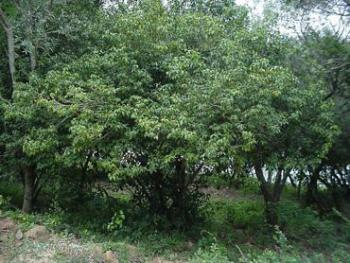Vepris reflexa
Vepris reflexa I.Verd.
Family: Rutaceae
Common names: bushveld white-ironwood (Eng.); bosveldwitysterhout (Afr.); umozane (isiZulu)
SA Tree No: 260
Introduction
Vepris reflexa is a glossy-leafed, evergreen tree with aromatic, apple-green foliage, which gives off a lemony scent when crushed. It grows large in the wild, but it makes an ideal indigenous tree for the medium-sized garden.

Description
Description
Vepris reflexa is a small tree up to 2–6 m tall. The trunk consists of stiff, erect branches and smooth, grey bark with fine cracks. The leaflets are leathery, drooping, more or less folded upwards along midrib and shortly stalked; the margins are entire, and unlike Vepris lanceolata, which has wavy margins with a sharp tip. The leaves smell like lemon when crushed. The middle leaflet has a longer stalk than side-leaflets.

The flowers are in short, axillary heads, small, greenish yellow. The fruits are orange-red, round and fleshy, with dotted glands. The buds open after the first rain (July–December).
Conservation Status
Status
According to the Red List of South African plants, Vepris reflexa is not screened as potential taxa of conservation concern, and was given an automatic status of LC (Least Concern). It is therefore, considered not to be under any immediate risk of extinction.
Distribution and habitat
Distribution description
It occurs in Gauteng, KwaZulu-Natal, Limpopo and Mpumalanga Provinces. It is most common in KwaZulu-Natal and Zululand. Vepris reflexa is not endemic to South Africa. It also extends into Mozambique, Swaziland and Zimbabwe. It occupies dry deciduous woodland and often found along rivers or on rocky hillsides up to 800 m altitude.

Derivation of name and historical aspects
History
Vepris reflexa is found under the family Rutaceae which is known as the buchu family. The genus Vepris, comprises ±_80 species of shrubs and trees, occurring mostly in tropical Africa and Madagascar. One species grows in India and a few on Mascarene Islands. Three species are known to occur in South Africa, and they are V. carringtoniana (= Teclea pilosa), V. lanceolata and V. reflexa. The specific name reflexa, is derived from the Latin meaning ‘reflexed’, referring to the typically curling leaflets.
Ecology
Ecology
The leaves of Vepris reflexa are generally browsed by elephant, and the fruits are eaten by birds. Several swallowtail butterflies (Papilio inidae) breed on V. reflexa.
Uses
Use
The wood is used for poles and posts in house building, fences, tool handles and utensils, e.g. walking sticks, clubs, spear shafts, bows and spoons. It is suitable for making furniture. It is used for charcoal production and also as firewood. No medicinal uses have been recorded.
Growing Vepris reflexa
Grow
Vepris reflexa is suitable for growing in a small garden and it takes well to pruning and shaping, and can make a great container plant. The white-ironwood can be propagated from seed, and the young plants transplant well. This plant is drought tolerant and water wise in its natural habitat, but even though that is the case, it is not suitable for very dry areas.
References
- Loffler, L. & Loffler, P. 2005. Swaziland tree atlas-including selected shrubs and climbers. Southern African Botanical Diversity Network Report No. 38. SABONET, Pretoria.
- Pooley, E. 2003. The complete field guide to trees of Natal, Zululand and Transkei, Edn 1. Natal Flora Publication trust. Pp.188, 189.
- Van Wyk, B. & Van Wyk, P. 1997. Field guide to trees of southern Africa. Struik, Cape Town.
- http://Redlist.sanbi.org
Credits
Aluwani Tshiila
KZN Herbarium 2015
August 2015
Plant Attributes:
Plant Type: Tree
SA Distribution: Gauteng, KwaZulu-Natal, Limpopo, Mpumalanga
Soil type: Sandy
Flowering season: Spring, Early Summer, Winter
PH: Neutral
Flower colour: Cream
Aspect: Full Sun
Gardening skill: Easy
Special Features:
Horticultural zones









Rate this article
Article well written and informative
Rate this plant
Is this an interesting plant?
Login to add your Comment
Back to topNot registered yet? Click here to register.